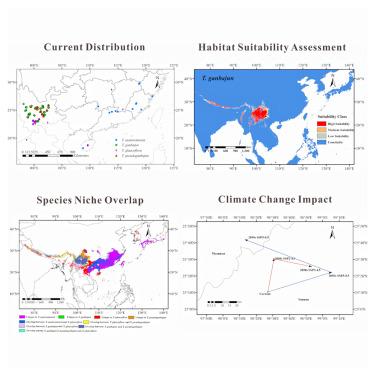Climate change impacts on the distribution of valuable Thelephora fungi in China
IF 4.1
2区 综合性期刊
Q1 MULTIDISCIPLINARY SCIENCES
引用次数: 0
Abstract
Thelephora includes valuable edible ectomycorrhizal (ECM) fungi in East Asia threatened by overharvesting, climate change, and habitat loss. Using Biomod2 ensemble modeling with bioclimatic variables, elevation data, and occurrence records, this study predicted current and future distributions of four Thelephora species under climate scenarios SSP2-45 and SSP5-85 for the 2050s and 2090s. The results indicate that the potential distribution ranges of these four Thelephora species are primarily influenced by Bio18 (precipitation of the warmest quarter), Bio12 (annual precipitation), elevation, and Bio3 (isothermality), though the relative importance of these factors varies among species. High-emission scenarios predict habitat reduction by 2050, with potential range expansion by 2090. Warming will drive northward habitat shifts, with migration distances increasing under high-emission scenarios. Over half of potential distribution areas contain non-host vegetation. Conservation strategies should prioritize host plant cultivation to expand fungal habitats and mitigate climate impacts.

气候变化对中国珍贵象属真菌分布的影响
该菌属包括东亚有价值的可食用外生菌根(ECM)真菌,这些真菌受到过度采伐、气候变化和栖息地丧失的威胁。基于生物气候变量、海拔数据和发生记录,利用Biomod2集成模型,对4种象属植物在SSP2-45和SSP5-85气候情景下的当前和未来分布进行了预测。结果表明,4种大象的潜在分布范围主要受生物圈18(最暖季降水)、生物圈12(年降水量)、海拔和生物圈3(等温)的影响,但这些因素的相对重要性因种而异。高排放情景预测,到2050年,栖息地将减少,到2090年,潜在范围将扩大。在高排放情景下,随着迁徙距离的增加,气候变暖将推动栖息地向北迁移。超过一半的潜在分布区含有非寄主植被。保护策略应优先考虑寄主植物种植,以扩大真菌栖息地和减轻气候影响。
本文章由计算机程序翻译,如有差异,请以英文原文为准。
求助全文
约1分钟内获得全文
求助全文
来源期刊

iScience
Multidisciplinary-Multidisciplinary
CiteScore
7.20
自引率
1.70%
发文量
1972
审稿时长
6 weeks
期刊介绍:
Science has many big remaining questions. To address them, we will need to work collaboratively and across disciplines. The goal of iScience is to help fuel that type of interdisciplinary thinking. iScience is a new open-access journal from Cell Press that provides a platform for original research in the life, physical, and earth sciences. The primary criterion for publication in iScience is a significant contribution to a relevant field combined with robust results and underlying methodology. The advances appearing in iScience include both fundamental and applied investigations across this interdisciplinary range of topic areas. To support transparency in scientific investigation, we are happy to consider replication studies and papers that describe negative results.
We know you want your work to be published quickly and to be widely visible within your community and beyond. With the strong international reputation of Cell Press behind it, publication in iScience will help your work garner the attention and recognition it merits. Like all Cell Press journals, iScience prioritizes rapid publication. Our editorial team pays special attention to high-quality author service and to efficient, clear-cut decisions based on the information available within the manuscript. iScience taps into the expertise across Cell Press journals and selected partners to inform our editorial decisions and help publish your science in a timely and seamless way.
 求助内容:
求助内容: 应助结果提醒方式:
应助结果提醒方式:


